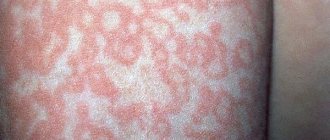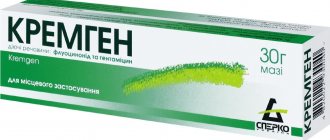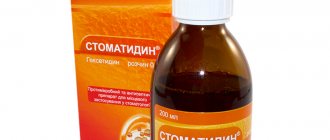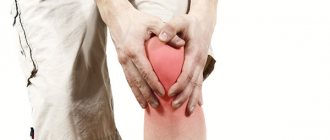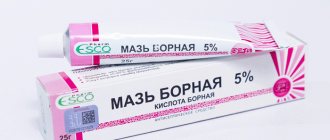What is boric alcohol
The drug is an antiseptic with an antifungal effect. Boric alcohol in the ears is used for inflammation inside and outside the auricle. The alcohol solution is a clear liquid with a pungent odor, available in the form of drops with 3 and 5% concentration. The first are used to treat otitis, and 5% - for severe ear inflammatory diseases. The drug has a high absorption rate by the skin.
Compound
According to its pharmacological action, alcohol is a disinfectant; it is a solution of boric acid in 70% ethanol. Available concentrations are 0.5, 1, 2, 3 and 5%. The antiseptic solution has antipruritic properties and is used to wipe healthy areas of the skin near areas of inflammation. The drug includes the active component boric acid (a white powdery substance, insoluble in water), dissolved in 70% ethyl alcohol.
Release form
Popular release formats are 10 ml bottles of 3 and 5% concentration, made of glass with plastic caps. There are volumes of 25 and 40 ml, dropper bottles with 10, 15 and 25 ml of product (equipped with polyethylene caps). The containers are packed inside cardboard packs, outside of which there are instructions for making gauze turunda. Additional formats are:
- powder - packets of 10, 25 g for preparing an aqueous solution before use;
- solution in glycerin – 10%, bottles of 25 ml;
- ointment – 5%, aluminum or plastic tubes of 10 and 15 ml.
Pharmacodynamics and pharmacokinetics
The active ingredient boric acid has antiseptic activity. It is applied topically and penetrates well through the skin and mucous membranes. It is especially quickly detected inside the blood of young children, so it is used with caution. Boric acid is slowly eliminated from the body and can accumulate inside organ tissues. When combined with alcohol, it increases blood circulation, warms, dilates blood vessels, and treats inflammation.
Boric alcohol - application
A popular indication for the use of boric alcohol is the disinfection of the skin of adults and children. Due to many side effects, restrictions on the use of the drug have been introduced. Today they are used to treat ears and dermatitis (skin inflammation). Boric alcohol is widely used for otitis (inflammation of the ear cavity) in the form of compresses and cotton wool inside the auricle, for congestion of the ear canals, and other ear diseases.
Disease Prevention
Many people develop eye diseases during their lifetime. This means that most problems can be avoided with the help of preventive measures.
To do this you need:
Have regular medical examinations with an ophthalmologist. They identify all eye diseases at an early stage, which will allow timely prevention of its development. Smart nutrition. You need to consume foods that have a beneficial effect on eye health. It is necessary to include in your diet foods that contain vitamins A, C and E. Keep your figure in shape. It's no secret that excess weight has an adverse effect on the quality of vision, since in this condition a person has increased pressure on the vessels that supply blood to the eyes
And if you take into account that they are too thin, then, accordingly, they can be easily damaged.
In addition to those mentioned, there are several more mandatory conditions for the prevention of eye diseases, namely:
- timely rest;
- use of sunglasses;
- to give up smoking.
By following these simple preventive measures, many eye diseases can be prevented, and if they occur, their development can be successfully slowed down. Take care of your eyesight.
Directions for use and dosage
For adults, boric alcohol is prescribed for acute and chronic otitis externa. Turundas (small narrow gauze swabs) are moistened with a solution and inserted into the ear canal. To treat affected areas of the skin with purulent inflammation (pyoderma), the skin is treated with rubbing. The course of treatment of chronic otitis media with an alcohol solution should not last more than a week, otherwise there is a risk of accumulation of toxins.
A 10% solution with glycerin is used to lubricate diaper rash and colpitis. When treating pediculosis, ointment is used. During operations after eliminating otitis media, powder can be used - insufflation or insufflation is performed. The course of therapy, dosage and method of administration are prescribed by the doctor after an individual examination of the patient and determination of the characteristics of the body. It is better not to self-medicate, because the acid is toxic.
Boric alcohol in the ear
If symptoms of otitis are detected, microbes have got inside the sink, boric alcohol will help in the child’s ear. After the first procedure, relief comes and the pain subsides. Instructions for its use:
- warm the medicine to room temperature in a water bath (cold medicine can lead to a sharp increase in ear pain);
- place one drop inside each child’s ear;
- after a minute, insert a small cotton wool so that it absorbs the remaining moisture;
- repeat twice a day until improvement occurs.
For complex therapy, adults can use drops and cotton compresses at night. In the first case, drip warm alcohol 3 drops three times a day in a lying position. In the second situation, soak turundas made of gauze and cotton wool in the product and place it in the ear canal overnight. To make the therapy more effective, clear the ear canal of earwax. Take a solution of hydrogen peroxide, drop 4-5 drops inside the ear, after a few minutes tilt your head so that the remaining wax flows out, clean the passage with a cotton swab.
- How to cook kharcho soup
- Obsessive-compulsive disorder - symptoms and treatment. Diagnosis of obsessive-compulsive disorder neurosis and test
- How to get rid of a black eye
For acne treatment
Due to its antiseptic properties, alcohol effectively reduces the number of acne on the face and other skin surfaces. There are several recipes to get rid of inflammation:
- Mix boric alcohol 3%, salicylic acid 1-2%, with a teaspoon of zinc ointment, shake. Let it brew for two hours and place it on the refrigerator shelf. Shake before use and apply to problem areas twice a day.
- If acne appears, mix 4 tablespoons of boric and salicylic alcohol with 10 tablets of Levomycetin, dissolve, apply to the skin twice a day.
- Combine 50 ml of a solution of boric and salicylic alcohol, 7 g of Streptocide and sulfur, apply to the skin in the evening, after 20 minutes - moisturizer.
- Fill 4 tablets of Clindamycin and Aspirin with 50 ml of medical alcohol and boric alcohol (in half). Shake, treat before bedtime for 10-14 days. Repeat the course in half a month.
Turunda in the ear
Ear turundas soaked in boric alcohol also help to quickly get rid of the symptoms of the disease.
The treatment option with turundas is allowed to be used even if the eardrum is damaged or boils are detected. Thanks to turundas, the warming effect lasts longer. To make turundas, gauze or bandage is useful. The material has a number of advantages over cotton wool. The most important advantage is the ability to pass air and water. Thanks to this property, there is no accumulation of inflammatory fluid. Other advantages of the procedure include:
- the medicine with which the turunda is soaked does not flow back;
- the drug is distributed evenly;
- long-term effect of the drug.
Rules that will come in handy when preparing turunda:
- strips 12 cm long and 8 mm wide are cut out of gauze fabric;
- the edges are folded inward;
- then the strip is folded in half;
- the resulting halves are twisted.
Advice. Since it is difficult to insert a moistened gauze turunda into the ear canal, the solution is instilled after its placement. Do not deepen the turunda too much; the tip must be visible.
special instructions
The instructions for use contain special instructions that should not be ignored when using the medicine:
- When absorbed, a toxic drug can lead to negative systemic effects, so boric alcohol should not be used in children at an early age (deaths are possible).
- Do not let the three percent alcohol solution get into your eyes, otherwise wipe with gauze or a cotton swab and rinse with warm water.
- Boric acid negatively affects the developing fetus during pregnancy; it is also prohibited during lactation because it is toxic.
- The drug is contraindicated in children under one year of age.
- Does not affect the speed of psychomotor reactions, and is not prohibited for use when driving vehicles or working with dangerous mechanisms.
Replacement with medications
- For ear diseases, antibacterial: “Tsipromed”, “Otofa”, “Fugentin”.
- Anti-inflammatory - "Otipax", "Otinum".
- For eye diseases: chloramphenicol, dexamethasone. For retinal dystrophy: emoxipin, taufon, actipol.
- For dermatitis: “Eplan”, “Skin-cap”, “Zinocap”.
Boric acid is an effective remedy for ear diseases. On our website you will find information on how to treat ears using compresses and turundas with this remedy, and also find out whether this medicine can be dripped into the ears during pregnancy.
Careful use of boric acid helps improve health, and also helps solve problems in some everyday issues, while the drug can be freely purchased at the pharmacy. By following safety precautions and only as prescribed by a doctor, this medicine will bring the desired effect.
Side effects
If symptoms of drug overdose occur, you must stop dripping the solution and carry out symptomatic treatment, including blood transfusion, hemodialysis, peritoneal dialysis. Side symptoms include:
- nausea, vomiting, diarrhea;
- local skin irritation, redness of the integument;
- skin rash, desquamation of epithelium, purulent skin condition;
- headache, confusion;
- convulsions, shock (even death);
- a sharp decrease in the amount of urine excreted;
- heart failure;
- overexcitation or lethargy;
- erythematosis, jaundice;
- disruption of the liver and kidneys, collapse.
Symptoms of the disease
Symptoms of otitis media can be different and feel different for each person.
The main early signs of otitis media include:
- feeling of ear fullness;
- swelling of the outer ear;
- increased body temperature;
- enlarged lymph nodes;
- hearing impairment;
- discharge from the ear;
- painful sensations.
Symptoms of otitis media can appear quickly, literally in one day, or slowly, up to a week. Therefore, it is often difficult to diagnose in the early stages and take appropriate measures.
In order to understand whether a patient has otitis media or not, you should lightly press on the tragus (a triangular cartilage on the outer ear). In the case of otitis media, the patient will experience pain. If we are dealing with another illness, pain syndrome will not be observed.
Contraindications
According to the instructions for use of the drug, the following contraindications are identified, in which it is not recommended to instill it or use it for wiping:
- pregnancy;
- breastfeeding (for treating the mammary glands);
- kidney dysfunction;
- age up to one year;
- individual intolerance, hypersensitivity to components;
- application to large surfaces of the body;
- damage (perforation) of the eardrum;
- purulent otitis media, severe ear infection;
- elevated body temperature.
How does salicylic acid differ from the above products?
Salicylic acid (C7H6O3) is a substance from the group of aromatic hydroxy acids. This substance was first obtained from willow bark. Later, the German chemist Kolbe was able to synthesize salicylic acid using a fairly simple method, which is still used today.
Salicylic acid was originally used to treat rheumatism. Currently, when there are a large number of effective means to combat this disease, this substance is used as an anti-inflammatory.
Salicylic acid is found in many combination products, such as:
- iprosalik;
- white-salik;
- viprosal;
- camphocin;
- zincundan;
- lorinden A;
- in lotions and creams "Clerasil";
- shampoos;
- tonics;
- gels;
- pencils and other forms.
At high concentrations, salicylic acid affects sensory nerve endings and is used to reduce pain.
Like other nonsteroidal anti-inflammatory drugs, salicylic acid is also used to constrict blood vessels and as an antipruritic agent.
It is recommended to use salicylic acid for the following indications:
- infectious and inflammatory skin diseases;
- increased sweating;
- excessive thickening of the stratum corneum of the epidermis;
- burns;
- eczema;
- psoriasis, pityriasis versicolor;
- seborrhea, hair loss;
- pyoderma (purulent skin lesion);
- erythrasma (superficial form of skin pseudomycosis);
- ichthyosis (disorder of keratinization of the skin - a hereditary disease);
- mycoses of the feet;
- acne;
- removal of warts;
- getting rid of calluses, blackheads, corns;
- dermatitis;
- lichen versicolor.
It should be remembered that when taken orally, salicylic acid, being a type of acid in general, has an irritating effect on the stomach.
People with diseases of the gastrointestinal tract should consult a specialist before taking products containing salicylic acid, which include such popular drugs as:
- aspirin (used mainly as an antipyretic);
- phenacetin (combined with other antipyretics);
- antipyrine (used in combination with other drugs);
- analgin (can be used in tablets and parenterally: subcutaneously, intramuscularly, intravenously);
- butadione (used in tablets);
- sodium salicylate - recommended for the treatment of rheumatism in the form of powder, tablets or solution, and is also administered in 10-15% solutions intravenously.
When treating rheumatism, salicylates are prescribed in large doses, so they can cause side effects:
- shortness of breath;
- noise in ears;
- skin rashes.
Attention! It must be remembered that the use of salicylic acid during pregnancy and lactation is not recommended.
Having become acquainted with all the substances, let’s summarize whether they are the same thing or not, what is the difference:
- boric alcohol is a derivative of boric acid and has the same medicinal properties - both substances are disinfectants;
- salicylic acid differs from the two mentioned substances in its structure, as well as its area of application - it is an anti-inflammatory and analgesic;
- When using all the drugs discussed, you must be careful and consult with specialists before use.
Boric alcohol price
You can buy the drug through an online pharmacy or visit your usual pharmaceutical department. The cost of the drug and its analogues depends on the form of release. Approximate prices:
| Name | Volume | Price when purchasing online, rubles | Price on the pharmacy shelf, rubles |
| Alcohol acid solution 3% | 20 ml | 25 | 35 |
| 25 ml | 32 | 40 | |
| Crystalline boric acid | 10 g | 48 | 54 |
| Ointment 5% | 25 g | 26 | 32 |
| Alcohol acid solution 2% | 25 ml | 72 | 85 |
How is it absorbed by the body?
Boric acid can penetrate into the blood. If you bury it correctly in the ear and exclude the possibility of penetration further than the outer ear, it has an antiseptic effect, eliminating the source of pain and inflammation.
After turning the head in the opposite direction, it should flow out freely. The remaining excess painlessly evaporates on its own.
Attention! If it enters the bloodstream if there is suppuration in the ear, boric acid is excreted by the body within one week through the kidneys. If this drug is used excessively, it can accumulate in the body, causing toxic poisoning.
